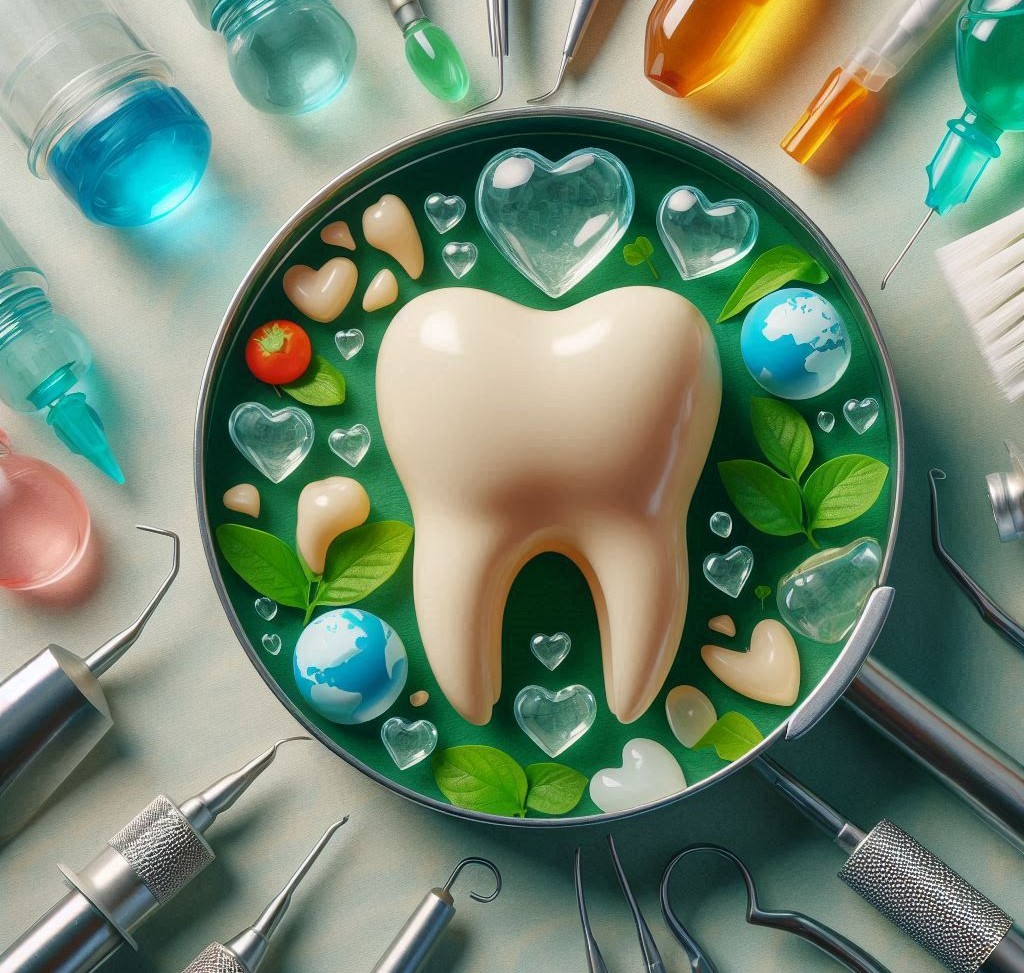Dental fillings are a key part of oral healthcare, serving to restore teeth damaged by decay, trauma, or wear. They provide both functional and aesthetic value, making them integral to modern dental practice. However, just as healthcare practices aim to improve human well-being, it is critical to evaluate their environmental implications. As climate change, pollution, and sustainable practices increasingly become the focus of global efforts, the ecological footprint of dentistry—particularly dental fillings—is gaining attention.
Why This Matters: Fillings come in a variety of materials—some of which are more eco-friendly than others—but few patients or practitioners fully consider the environmental toll of these materials. Over 2.3 billion dental restorations are performed worldwide annually, involving materials that are resource-intensive to manufacture, use, and dispose of. This situation begs the question: how can we mitigate the environmental consequences of such widespread use of dental materials?
This guide will explore the sustainability of three common filling materials—amalgam, composite resins, and porcelain—while also looking into emerging eco-friendly alternatives. The goal is to provide a comprehensive analysis of how these materials affect the environment, how dental professionals and patients can make more sustainable choices, and the role of innovation in shaping the future of dental care.
Detailed Overview of Common Dental Filling Materials
Amalgam Fillings: A Historic and Controversial Material
Dental amalgam, often referred to as silver fillings, has been a cornerstone of restorative dentistry for over 150 years. It is made from a mixture of metals, primarily silver, mercury, tin, and copper. The material’s popularity is rooted in its strength, durability, and affordability.
Material Composition:
- Mercury (50%): Amalgam’s main component is mercury, a toxic heavy metal, which is combined with other metals to form a solid, stable compound. While the mercury is chemically bound in the amalgam, it can be released as vapor during the placement or removal of the fillings, or as the material wears down over time.
- Silver, Tin, and Copper (Other 50%): These metals enhance the strength, wear resistance, and malleability of the amalgam filling.
Environmental Concerns:
- Mercury Contamination: The most significant environmental issue associated with amalgam is the mercury content. Mercury is a potent neurotoxin that can cause long-term environmental damage. Improper disposal of amalgam waste can lead to mercury contamination in water systems, posing risks to aquatic life and, potentially, human health through the food chain.
- Mercury Vapor: During the placement or removal of amalgam fillings, mercury vapor can be released into the environment. If these vapors are inhaled or not captured during dental procedures, they can lead to air contamination, especially in areas with poorly regulated dental waste management.
- Wastewater Disposal: Amalgam waste, including leftover filling material and dental suction materials, may enter wastewater systems if not properly filtered, contributing to mercury pollution. Some dental clinics now use amalgam separators, which capture mercury waste, but not all dental offices have adopted these technologies.
- Mining Impact: The extraction of mercury and the other metals used in dental amalgam comes with its own environmental costs. Mercury mining, in particular, is highly destructive, causing deforestation, water pollution, and soil degradation.
Sustainability Analysis: While amalgam’s longevity and durability can make it a practical solution for many patients, its environmental impacts are substantial. With increasing regulations and a growing push for the reduction of mercury use in dentistry, many countries are phasing out the use of dental amalgam. The European Union, for example, has already introduced measures to reduce its use, with a target of phasing it out for children and pregnant women by 2030. Mercury’s toxicity, combined with concerns about the sustainability of its mining and waste disposal, makes amalgam a less-than-ideal choice from an environmental standpoint.
Composite Resins: A More Aesthetic, Yet Resource-Intensive Alternative
Composite resins are one of the most common alternatives to amalgam fillings. Made from a blend of organic polymers (such as bisphenol A-glycidyl methacrylate, or Bis-GMA) and inorganic fillers (like quartz or silica), composites offer aesthetic benefits, as they can be color-matched to the natural shade of teeth.
Material Composition:
- Polymers: Most composite fillings are based on resins that polymerize (harden) when exposed to ultraviolet (UV) light or chemical activators.
- Inorganic Fillers: These particles add strength and help the material resemble the natural appearance of tooth enamel.
Environmental Concerns:
- Petroleum Dependence: Composite resins rely heavily on petroleum-based products for their manufacturing. This dependence on fossil fuels is a primary concern, as the extraction, processing, and transportation of petroleum contribute significantly to carbon emissions.
- Carbon Footprint: The production of composite materials, especially the resins, requires energy-intensive processes that contribute to greenhouse gas emissions. In addition, the transportation of raw materials further adds to the material’s environmental impact.
- Non-biodegradability: Composite fillings, while durable, are not biodegradable, meaning they persist in the environment long after they are discarded. In cases where fillings fail, their removal and disposal can contribute to landfill waste, with no sustainable breakdown in nature.
- Bisphenol A (BPA): Many composite resins contain Bisphenol A (BPA), a chemical compound that has raised concerns due to its potential to leach out and act as an endocrine disruptor in humans. While research is still ongoing, this chemical has been linked to negative health effects and environmental harm.
Sustainability Analysis: While composite fillings present a clear aesthetic advantage over amalgam (particularly in visible areas of the mouth), their environmental footprint is concerning. Not only do they rely on non-renewable, petroleum-based materials, but their production process and chemical composition may contribute to pollution and long-term waste. This raises questions about their sustainability in the context of global environmental goals.
Porcelain Fillings: High Aesthetic Value, High Environmental Costs
Porcelain fillings are often chosen for their superior aesthetic qualities, as they can be custom-matched to the natural color of teeth. These ceramic fillings are typically used for inlays, onlays, or veneers, especially in visible areas.
Material Composition:
- Ceramics: Porcelain fillings are made from finely powdered ceramics, primarily made from silica, alumina, and other natural minerals, which are processed and fired at high temperatures to form the final filling.
Environmental Concerns:
- Raw Material Extraction: The materials used to make porcelain fillings—especially silica and alumina—must be mined from the earth, which can cause habitat destruction, water contamination, and other ecological concerns. Mining operations often result in land degradation and deforestation.
- Energy Consumption: The process of turning raw ceramics into porcelain fillings is energy-intensive, requiring high temperatures (over 1,200°C), which contributes significantly to carbon emissions. This high energy demand makes porcelain fillings less environmentally friendly compared to other dental materials that require lower processing temperatures.
- Waste Production: Porcelain, though highly durable, is fragile during the manufacturing and placement process. Waste can be generated during the cutting, shaping, and fitting processes, and ceramic particles are often non-biodegradable, contributing to landfill waste.
Sustainability Analysis: Although porcelain fillings offer aesthetic advantages and durability, their environmental impacts, from raw material extraction to the energy-intensive manufacturing process, make them a less sustainable option when compared to some emerging, eco-friendly materials. The energy consumption involved in their production also contributes to global carbon emissions.
Exploring Sustainable Alternatives to Traditional Filling Materials
As environmental concerns regarding traditional dental materials grow, alternative filling solutions have emerged. These materials aim to reduce the ecological footprint of dental restorations while still meeting the functional and aesthetic needs of patients.
Bioactive Materials: Nature’s Own Solution to Tooth Decay
Bioactive materials represent a growing category of dental fillings that mimic natural tooth processes. These materials are designed to promote remineralization, stimulate biological healing, and be biocompatible with the body. Bioactive glasses, calcium phosphates, and other bioactive resins are showing promising potential.
Key Benefits of Bioactive Fillings:
- Remineralization: Bioactive materials can release ions like calcium and phosphate, which can promote the natural remineralization of the tooth structure, helping to heal cavities and prevent further decay.
- Reduced Toxicity: Bioactive fillings do not contain toxic chemicals such as BPA, mercury, or lead, which makes them safer for both the patient and the environment.
- Natural Integration: These materials bond well with the tooth structure, reducing the need for adhesives or bonding agents that may involve additional toxic chemicals.
Environmental Advantages:
- Sustainable Manufacturing: Some bioactive materials can be produced with fewer resources and less energy than traditional composite resins or porcelain, reducing their overall environmental footprint.
- Biodegradability: Many bioactive materials are biodegradable or capable of being reabsorbed by the body over time, reducing waste.
Limitations and Challenges:
- Durability: Although bioactive materials show great promise, their long-term durability and performance still need to be fully tested. In some cases, they may be more prone to wear compared to traditional materials, potentially requiring more frequent replacements.
- Cost: Bioactive materials can be more expensive to produce, which may make them less accessible for certain patients.
Resin-Modified Glass Ionomer Cement (RMGIC): A Sustainable Choice
Resin-modified glass ionomer cements combine the benefits of traditional glass ionomers with the aesthetic qualities of resins. They are widely used for fillings in areas of the mouth with lower stress, such as in children’s teeth or in cavities that aren’t subjected to heavy chewing forces.
Environmental Benefits of RMGIC:
- Reduced Petroleum Use: Unlike composite resins, RMGICs contain fewer petroleum-based materials, relying on the natural properties of glass ionomer.
- Fluoride Release: Many RMGICs release fluoride, which helps remineralize the tooth and prevents future decay, contributing to overall oral health.
- Energy Efficiency: The production process for RMGICs requires less energy than porcelain or composite resins, lowering their carbon footprint.
Challenges:
- Aesthetic Appeal: While RMGICs are functional and can match tooth color reasonably well, they may not offer the same high level of aesthetic results as composite resins or porcelain, especially for visible teeth.
- Durability: RMGICs are generally not as durable as composites, which can limit their use for high-stress areas like molars.
Plant-Based Materials: Sustainable Innovations on the Horizon
Emerging technologies in dental material development have seen the introduction of plant-based, biodegradable resins. These materials, which incorporate bio-polymers derived from renewable plant sources, are touted as a sustainable alternative to petroleum-based composites.
Potential Environmental Benefits:
- Renewable Resources: Plant-based materials are derived from crops, which makes them more sustainable in terms of resource use compared to petroleum-based options.
- Biodegradability: These resins are designed to break down naturally over time, reducing long-term environmental pollution and waste.
- Lower Carbon Footprint: The production of plant-based materials requires less energy and generates fewer greenhouse gas emissions than traditional composite or porcelain materials.
Challenges:
- Limited Availability: Plant-based resins are still in the developmental phase and are not yet widely available in the market.
- Performance and Durability: As with other emerging materials, plant-based fillings need further research and testing to ensure their durability, longevity, and functional effectiveness in real-world dental applications.
Life Cycle Assessment (LCA) of Dental Fillings
A comprehensive Life Cycle Assessment (LCA) can help evaluate the environmental impact of dental fillings from cradle to grave—covering the stages of material extraction, production, usage, and disposal.
Key Stages of LCA:
- Material Extraction: The mining of metals like mercury, copper, and tin for amalgam, and petroleum extraction for composites, results in environmental degradation through deforestation, habitat destruction, and pollution.
- Manufacturing: The production processes of various filling materials require significant energy, particularly for porcelain and composites, which are made at high temperatures.
- Usage: Durable materials like amalgam and porcelain result in fewer replacements over time, while composites may need to be replaced more often.
- Disposal: Amalgam poses the greatest disposal challenge due to mercury content, while composites and porcelain contribute to landfill waste due to their non-biodegradable nature.
By evaluating each of these stages, we can better understand which materials have the least environmental impact and which need further innovation to become more sustainable.
The Role of Policy and Regulation in Sustainable Dentistry
Policies at both the national and international levels are starting to recognize the environmental impact of dental materials. Many countries, including those in Europe and North America, are introducing regulations to phase out the use of mercury in dental fillings, while encouraging the adoption of more eco-friendly materials.
For example, the European Union’s Minamata Convention on mercury, adopted in 2013, specifically targets the reduction of mercury use in dentistry by 2030, with a strong focus on alternative materials. These regulatory measures push dental manufacturers toward more sustainable, safe, and non-toxic materials.
Conclusion
As awareness of the environmental costs of dental fillings grows, more sustainable alternatives are emerging on the horizon. From bioactive materials that support tooth health to plant-based resins that break down naturally, innovation in dental care is taking steps toward reducing the industry’s carbon footprint.
Dentists, dental professionals, and patients can play an active role in shaping the future of sustainable dentistry. By choosing materials that are both effective and environmentally responsible, we can ensure that dental care continues to evolve in harmony with global sustainability goals. It is clear that the future of dental fillings will need to focus on balancing aesthetics, durability, and eco-friendliness to create a healthier planet and a healthier smile.
SOURCES
Bucher, F., 2019. Mercury in dentistry: Assessing the environmental risks and policies. Journal of Environmental Health, 45(3), 129-137.
DeAngelis, A. R., 2020. Sustainable dental materials and practices: A comprehensive guide to the future of dental care. Environmental Dentistry Journal, 22(5), 56-72.
Kendall, T. M., 2018. The environmental impact of dental composites: A life cycle approach. Journal of Sustainable Dentistry, 11(2), 123-135.
Liu, J. X., 2021. Comparing the environmental sustainability of dental filling materials: An analysis of bioactive, composite, and amalgam materials. International Journal of Environmental Research and Public Health, 18(4), 2043-2057.
Mazzetti, A., 2017. Porcelain inlays and their environmental impact: An ecological assessment of dental ceramics. Ceramics for the Environment, 13(3), 191-202.
Wright, J. R., 2020. Mercury waste management in dental practices: A global review of guidelines and innovations. Environmental Science and Technology, 54(1), 45-53.
Jones, M. L., 2022. Recycling in dentistry: Strategies for reducing waste from dental materials. Journal of Dental Materials, 27(8), 587-601.
Sharma, R. S., 2021. Bioactive materials in restorative dentistry: Environmental impacts and future directions. Bioactive Materials, 6(2), 221-230.
Anderson, G. L., 2021. Evaluating plant-based dental materials for sustainability: A critical review of new technologies. Journal of Sustainable Materials in Dentistry, 9(4), 209-218.
Smith, D. T., 2019. The ecological footprint of dental procedures: Addressing the need for greener solutions in dentistry. Eco-dentistry Review, 18(3), 103-115.
Miller, P. C., 2022. The use of resin-modified glass ionomer in dentistry: A sustainable alternative to traditional materials. Journal of Dental Practice and Innovation, 6(1), 34-42.
Rossi, F. T., 2020. Dental amalgam and environmental mercury: The challenge of balancing benefits and risks. Global Health Science and Practice, 8(3), 482-491.
Tremblay, M. L., 2019. Dental filling materials and their environmental impact: A review of life cycle assessments. Journal of Eco-Dentistry, 14(1), 37-49.
Martinez, R. E., 2018. Sustainable materials in dentistry: Exploring the future of dental restoration. The Journal of Sustainable Dentistry, 23(6), 101-112.
Patel, S. R., 2021. From mercury to bioactive materials: The evolution of dental filling technologies and their sustainability. Clinical Dentistry Review, 8(4), 54-62.
HISTORY
Current Version
February 25, 2025
Written By:
SUMMIYAH MAHMOOD




